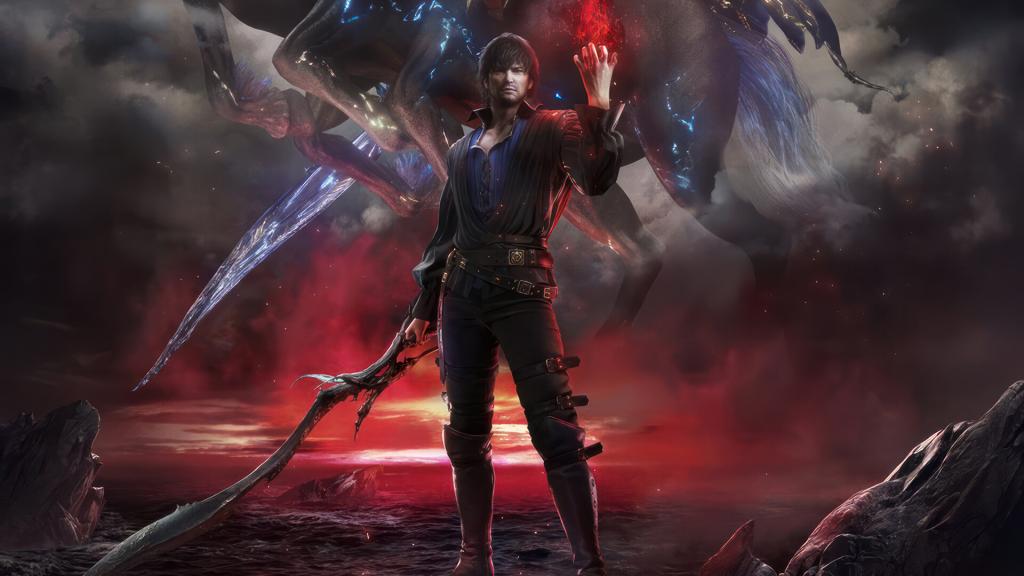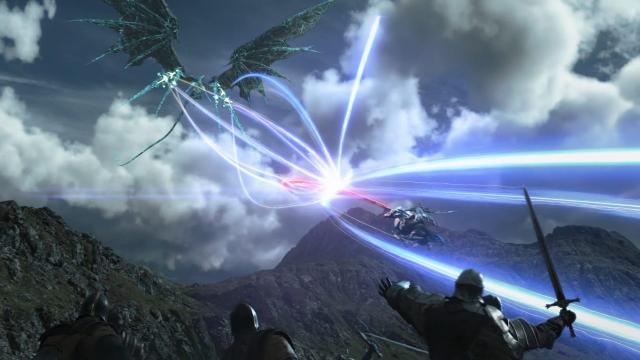There are few sights more beautiful in life than that of two giant monsters absolutely beating the shit out of each other in a spectacle of epic, cinematic violence. TV shows, movies and video games have been recreating this pinnacle of fine art for decades, but few have managed to capture its majesty quite as well as Final Fantasy XVI, whose Dominants and Eikons are tailor-made to just totally go to town on one another in an orgy of glorious (and let’s be honest, pretty sexually charged) physical conflict. Because really, what could be better than that? …Stupid question! The only thing better is obviously discussing the socio-political and military ramifications that these godlike monsters should have had on the world-building of Valisthea, and why the focus on one-on-one monster action has prevented us from asking the real questions, like; why have all these armies when your Eikon is a dragon that can shoot laser beams? Where are all the assassins in this political drama? And why is Titan fighting a war when his powers are obviously far better suited to revolutionizing agriculture through the manipulation of soil nutrients?
Our discussion begins where FFXVI seeks to place its emphasis — the military machinations of Valisthea. The history of the twin continents is rife with military conflict, conquest and just a whole bucket-load of war crimes. Throughout this history, Eikons have supposedly been a pivotal force in deciding the outcome of these conflicts. But in all the battles we witness in-game, the god-like Eikons seem to be relegated to sitting on their thumbs until another Eikon shows up, at which point they wrestle for a few minutes before getting tuckered out and having a nap. So what purpose are they actually serving in the military? The answer, in short, is that the Eikons are primarily being used as supplemental agents to the primary military might of a standing army — effectively taking on the role of an escorting superweapon to ensure that the army is able to reach and claim its military objective without being thwarted by the superweapon of the enemy. This strategy is logical enough, I suppose, but it raises a far more interesting world-building question. Why not cut out the middleman? If your Eikon is capable of decimating an entire army virtually unscathed, why is everyone fielding armies in battle at all?
The purpose of a standing army isn’t limited to active military combat, of course. Their primary function in a feudal setting like Valisthea tends to be enforcing the compliance of the populace through the threat of physical violence, acting as a militant police force (you know, in the same way that our modern-day police are an occupying government force with a monopoly on legally applied violence). This purpose is especially important in a setting with such an emphasis on slavery, as the army has a vital role in ensuring that the slave caste of the nation doesn’t seek emancipation. With these factors in mind, it wouldn’t make sense for the nations of Valisthea to be without their own standing armies.
But again, I ask, why are they actually fielding them in battle? The resources spent on supplying a military campaign for an entire army would be exorbitant, particularly when you consider that every nation in Valisthea is currently experiencing food shortages due to the encroaching Blight. Marching an army across the continent to engage in a gruelling campaign of conquest is too taxing an endeavour to be cost-effective, and that’s without factoring in the dangers of deploying your police force away from home during a period of mass discontent and potential revolt. And even if you do succeed in conquering another nation, what exactly have you achieved? You may have more land, but now you also have more mouths to feed as the non-military population of the conquered nation are now your citizens, unless you’re planning to diversify your war crimes with some wholesale slaughter. The standing armies of Valisthea’s nations serve far better as threats of violence and potential occupying forces rather than actual military assets, and that’s without even factoring in how bad an idea it is to field them against an Eikon, where combat is virtually guaranteed to end in the mass slaughter of troops at the hands (or claws, fireballs, laser beams, etc.) of these godlike creatures.
So why aren’t Eikons being used more actively in conquest? The answer to this question seems to be “because if we use our Eikon, the enemy will just use theirs” — the ‘Eikons are an analogy for nuclear weaponry’ argument that implies mutually assured destruction as a reason for their limited use in Valisthean conflict. But there are some extremely important differences that make Eikons far more effective at avoiding mutually assured destruction than the use of nuclear weaponry;
- The Dominant hosts are mobile and, therefore, difficult to predict. With effective use of stealth, they can appear as Eikons at strategic locations with very little warning or time to respond.
- Eikons don’t necessarily cause long-term damage to the environment in the way that nuclear weaponry inevitably does, thereby allowing a military force to move in afterwards to take over.
- It is far easier to disarm an enemy nation of their Eikon through the use of one key strategy underutilized in Valisthea thus far — assassination.
The Eikons of Final Fantasy XVI are godlike beings capable of overwhelming destructive power, but they possess one glaring weakness that we never see exploited to its logical conclusion — the Dominant human form itself. A primed Eikon is effectively unkillable – able to regenerate from catastrophic damage, endure in the vacuum of space, and channel quantities of aether that would see mortal bodies immediately succumb to the Crystals’ curse. While an Eikon might temporarily reflect the injuries of their Dominant’s mortal body, even these hindrances are overcome near-instantly through regeneration. An Eikon cannot be destroyed, only forced to revert back into the form of the human Dominant who channels them. Therefore, the best way to handle an Eikon isn’t with another Eikon — in fact, it seems like most clashes between Eikons end in a stalemate with no real progress for either side. The best way to handle an Eikon is to kill the Dominant before they can even prime! So now we come to one of the biggest questions raised by the world-building of Final Fantasy XVI, and one that I have no clear answer for; where are all the spies and assassins?!
In a feudal setting with an emphasis on political machinations on a continental scale, there is a criminally negligent number of secret societies, cabals of assassins, and other such skullduggerous organizations. It’s hard to imagine a setting with more emphasis on extremely powerful individuals who are only vulnerable when caught unaware, and where a dagger in the back or a knife applied judiciously up the arse via latrine (history is wild, look it up) would solve the primary military threat to a nation. It almost feels like the concept of assassination is entirely foreign to Valisthea, which would explain why important political figures have a tendency to just show up unguarded in the capital cities of their enemies during an active war solely to smugly deliver one-liners (looking at you here, Anabella Rosfield)! If Final Fantasy XVI were actually Game of Thrones, as it is sometimes compared to in tone and setting, every one of its main characters would be dead within days because they have the survival instincts of a sky-diving lemming, sans-parachute. But frankly, there’s no excuse for this egregious lack of paid murder in Valisthea, and the only explanation I can think of is that it would, admittedly, be a bit of a video game downer if we never saw Titan fist-fight Ifrit in a Denny’s parking lot because he was shanked off-screen two hours earlier.
From the Grand Duchy of Rosaria to the Holy Empire of Sanbreque, the Iron Kingdom and the Dhalmekian Republic, it seems like none of these nations on Valisthea have actually thought about how to wage war effectively, taking into account the actual strengths and weaknesses of Eikons, and their effects on military strategy. Rather than placing their military might into bloated and slow standing armies with Eikons in supporting roles, they should be developing well-trained, covert strike teams whose objectives are the systematic identification and elimination of enemy Dominants, the assassination of key political figures, and the destabilization of population centres via the agitation and arming of existing dissenters such as the Branded slave-caste and struggling proletariat. Once the enemy Dominants have been eliminated (or during the later stages of the process), your own Dominants can engage in guerilla warfare, travelling through enemy territory to perform surgical strikes with their Eikon, enacting swift annihilation of key strategic positions in order to dismantle the strength and security of their nation. An obvious first target would be the government bodies of the enemy nation, which on Valisthea, are bafflingly easy to identify and eliminate because everyone seems to be ruling from tall, precarious towers vulnerable to Eikon attacks. With their leadership eliminated, military assets dismantled, and the population rising up, conquest would be quick, easy and relatively painless. The Holy Empire of Sanbreque is perhaps closest to this military strategy with their Branded suicide squads and elite Dragoons, but the Holy Emperor and his Council of Cardinals seem to lack the understanding of how to best employ these assets. In the entirety of Valisthea, there is only one nation that actually understands the benefits of military strategy, and its leader isn’t even from Valisthea. I speak, of course, of:

Barnabas Tharmr, king of Waloed and the Dominant of Odin, is Valisthea’s sexiest m– I mean, the only competent ruler in Valisthea. Having conquered the entire continent of Ash, Barnabas does now use his standing army and Eikon in battle as seemingly ineffectively as the other nations of Valisthea, but this is a scapegoat for his actual methods and strategy. With enemy attention focused solely on himself and his army, the ‘intelligencers’ under his employ are able to perform surgically precise military operations on enemy soil virtually undetected, led by Benedikta, the Dominant of Garuda. Her manipulations of the Dominant Hugo Kupka led to the Eikon Titan being effectively hers to direct, and it was only the appearance of Mr. Plot Armour himself, Clive Rosfield, that this covert strike force was thwarted in their activities within the continent of Storm. Had Barnabas actually wanted to conquer the other nations, it seems likely that he would’ve had little trouble doing so. Unfortunately, a space ghost found out about his Oedipus complex and decided he’d be a great tool with which to destroy humanity.
Of all the nations on Valisthea, only Waloed has adapted its military and political strategies to best take advantage of Eikons and their powers, but even they don’t reflect the full effects that the existence of Eikons should have had on Final Fantasy XVI’s world-building. A feudal setting inspired by real-world civilizations is fine, but it sadly feels like a missed opportunity to double down and really explore what it would mean for a world if godlike monsters walked among us. Still, I can’t complain too much about a game that let me watch a fire monster tell a mountain with tentacles to stop hitting himself. Big beautiful monster boys are wrestling in space for the fate of humanity, and isn’t that all we can ask for, in the end?
…no, it isn’t! Where’s my boy Leviathan?! He deserved better!

Leave a Reply